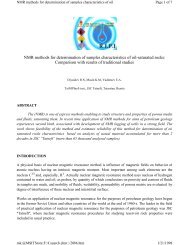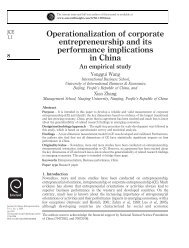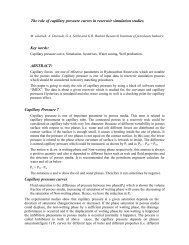Corporate entrepreneurship: teaching managers to be entrepreneurs
Corporate entrepreneurship: teaching managers to be entrepreneurs
Corporate entrepreneurship: teaching managers to be entrepreneurs
You also want an ePaper? Increase the reach of your titles
YUMPU automatically turns print PDFs into web optimized ePapers that Google loves.
JMD22,4344enough. Do companies really need <strong>to</strong> change their culture, or get a coupleof big wins every few years? Perhaps many organizational consultantshave put <strong>to</strong>o much effort in<strong>to</strong> organizational change as a pre-requisite <strong>to</strong>venturing. May<strong>be</strong> more emphasis on venturing first, and a few wins,would do more <strong>to</strong> change the culture than the other way around.ReferencesAltman, J. (2000), “Xerox new enterprises” (case study), Arthur M. Blank Center forEntrepreneurship, Babson College, Wellesley, MA.Block, Z. and MacMillan, C. (1993), <strong>Corporate</strong> Venturing, Harvard Business School Press, Bos<strong>to</strong>n,MA.Bygrave, W (Ed.) (1997), The Portable MBA in Entrepreneurship, Wiley, New York, NY.Covin, J. and Slevin, D.P. (1991), “A conceptual model of <strong><strong>entrepreneurs</strong>hip</strong> as firm <strong>be</strong>havior”,Entrepreneurship Theory and Practice, Vol. 15, pp. 7-24.Covin, J.G. and Miles, M.P. (1999), “<strong>Corporate</strong> <strong><strong>entrepreneurs</strong>hip</strong> and the pursuit of competitiveadvantage”, Entrepreneuship Theory and Practice, Vol. 23 No. 3, pp. 47-63.Greco, J. (1999), “Strategists of the century: Walt Disney”, Journal of Business Strategy, Vol. 20No. 5, pp. 33-4.Hood, J. and Young, E. (1993), “Entrepreneurship’s requisite areas of development: a survey of<strong>to</strong>p executives in entrepreneurial firms”, Journal of Business Venturing, Vol. 8 No. 2,pp. 115-36.Morris, M. (1998), Entrepreneurial Intensity, Quorum Books, London.Pearce, J.A., Kramer, T.R. and Robbins, D.K. (1997), “Effects of <strong>managers</strong>’ entrepreneurial<strong>be</strong>haviour on subordinates”, Journal of Business Venturing, Vol. 12 No. 2, pp. 147-60.Pinchot, G. III (1985), Intrapreneuring, Harper & Row, New York, NY.Roepke, R., Agarwal, R. and Ferratt, T.W. (2000), “Aligning the IT human resource with businessvision: the leadership imperative”, MIS Quarterly, Vol. 24 No. 2, pp. 327-53.Schrage, M.D. (1999), “Serious play: how the world’s <strong>be</strong>st companies stimulate innovation”,Research Technology Management., Vol. 42 No. 6, p. 58.Schumpeter, J.A. (1934), The Theory of Economic Development, Harvard University Press,Bos<strong>to</strong>n, MA.S<strong>to</strong>pford, J. and Baden-Fuller, C.W. (1993), “<strong>Corporate</strong> <strong><strong>entrepreneurs</strong>hip</strong>”, in Lorange, P.,Chakravarthy, B., Roos, J. and Van de Ven, A. (Eds), Implementing Strategic Processes:Change, Learning and Cooperation, Blackwell, Oxford, pp. 91-114.S<strong>to</strong>pford, J.M. and Baden-Fuller, C.W. (1994), “Creating corporate <strong><strong>entrepreneurs</strong>hip</strong>”, StrategicManagement Journal, Vol. 15, pp. 521-53.Timmons, J. (1989), The Entrepreneurial Mind, Brick-House Publishing Company, Andover, MA.
















